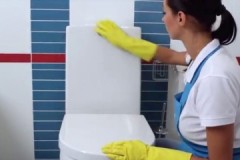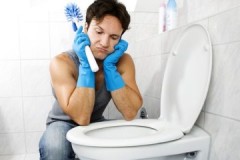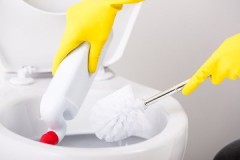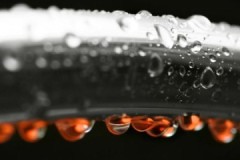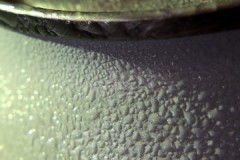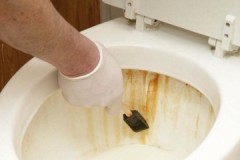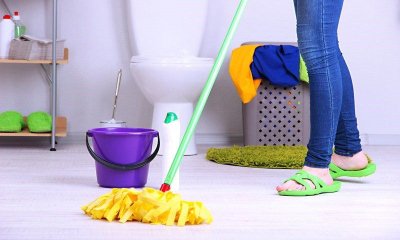 A toilet room and toilet, shining with cleanliness, is the dream of every housewife.
A toilet room and toilet, shining with cleanliness, is the dream of every housewife.
This result can be achieved if you strictly follow the cleaning schedule and select the right equipment and means for washing and disinfection.
The advice of experienced housewives and professional cleaners will help with this. You will find all the most important things about cleaning the toilet in this article.
Content
Rules for cleaning the bathroom in the house
Before you begin the fight against pathogenic microbes, plaque and unpleasant odors in the toilet, you need to audit your cleaning equipment and become familiar with the sequence of cleaning surfaces for an impeccable result.
Necessary equipment
To clean problem areas you will need:
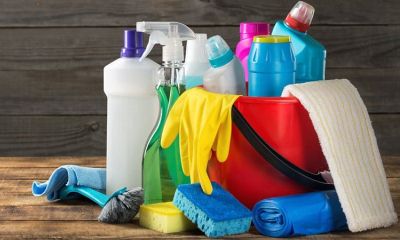 rags, napkins, sponges, brushes for various surfaces;
rags, napkins, sponges, brushes for various surfaces;- toilet brush;
- mop for cleaning the floor;
- containers for cleaning solutions and clean water (basins, buckets);
- detergents and disinfectants;
- spray;
- rubber gloves, respirator or mask.
Cleaning the toilet It is better to carry out in clothes specially designated for this purpose.
After manipulation, equipment must be disinfected to prevent the spread of microorganisms: rinse thoroughly, treat with a special agent, and dry.
How to wash?
When cleaning the bathroom, you should follow a certain order so as not to do the same job twice.
Step by step steps:
- Wear work clothes and protective equipment.
- Take out the trash, remove rugs and anything unnecessary.
- Clean and disinfect walls, doors, cabinets, mirrors, shelves, windows.
- Remove water from the toilet.
- Wash and treat its bowl, outer walls and components with a chlorine-containing solution.
- Wash the floor and wipe it dry.
Selecting a Cleaning Product
Manufacturers of household chemicals for home cleaning offer a variety of concentrates, gels and liquids for toilet bowls.
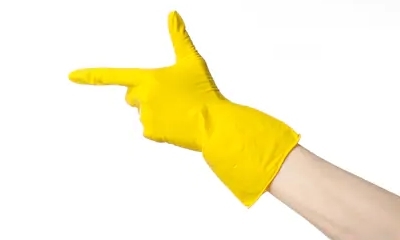 To make the right choice, it is necessary to identify the main problem of pollution and pay attention to the composition of the product:
To make the right choice, it is necessary to identify the main problem of pollution and pay attention to the composition of the product:
- Surfactant – removes common stains;
- acids - dissolve uric and limescale deposits;
- alkali – fights rust and organic contaminants;
- chlorine – bleaches, eliminates odors and fights microorganisms.
Fragrances in cleaning solutions are an optional component; they deodorize the problematic surface and mask the pungent odor of household chemicals.
Popular toilet cleaning products:
- Bref Power Gel 6 in 1. A universal concentrated product that fights rust, limescale and organic dirt, and disinfects surfaces.
- Comet 7 days of cleanliness. Multifunctional spray effectively removes all types of plaque in the toilet and protects against microorganisms.
- Dressing Duckling Super power visible effect. The gel in a container with a convenient spout penetrates into hard-to-reach places, copes with all known types of contaminants, and destroys pathogenic microbes.
Housewives note that universal products reduce cleaning time and allow you to save money. An overview of effective toilet cleaners is presented in this material.
Surface cleaning
Cleaning the bathroom must be done in a certain sequence., detergents should be selected depending on the material.
Walls
The side surfaces of the toilet are usually tiled. For effective cleaning at home, you can use folk recipes using budget components.
Step-by-step instruction:
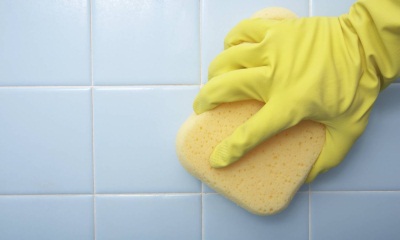 Prepare a solution of water (1 liter) and table vinegar (200 ml).
Prepare a solution of water (1 liter) and table vinegar (200 ml).- Treat the tiles with the prepared liquid from a spray bottle.
- Dilute crushed chalk in warm water to a paste consistency.
- Apply to surface with a sponge.
- Rinse off with a cloth dampened in clean water.
- Wipe dry.
If you add 100 g of baking soda to the chalk slurry, you can restore the whiteness of the seams between the tiles.
Toilet and its components
You should not limit yourself to cleaning the plumbing bowl. It is necessary to wash the interior, exterior and components.
For perfect cleanliness, the toilet lid requires daily cleaning with a sponge using a soap solution. It is necessary to wash the tank and drain handle. A universal washing liquid is suitable for this; you can prepare a soda solution.
To quickly clean the bowl, experienced housewives use a solution of hydrogen peroxide and ammonia in a ratio of 9:1.
Rugs
Before cleaning, they must be collected and shaken well to remove dust and debris.
To wash or clean the product, a label with the manufacturer’s recommendations will tell you. The final stage should be drying in the fresh air.
If the rugs are not dried well, mold may appear on them under the influence of moisture, which will be more difficult to get rid of than everyday dirt and microorganisms.
Floor
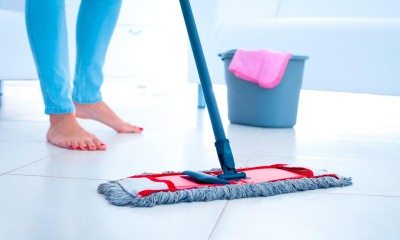 The last stage of general cleaning in the toilet room. The goal is to clean the surface of contaminants and disinfect it.
The last stage of general cleaning in the toilet room. The goal is to clean the surface of contaminants and disinfect it.
The first time it is necessary to treat it with a detergent, the second time you need to add a small amount of an industrial solution based on bleach (sodium hypochlorite) to the water or prepare a homemade mixture with bleach.
It is often advised to add ethyl alcohol to water, but the component is ineffective in this situation. A 9% vinegar solution will bring much more benefit..
Cleaning the floor should start from the baseboards, continue from the walls to the center and then to the exit.
How to clean plaque from plumbing fixtures at home?
To effectively rid the surface of the toilet bowl of contamination, it is necessary to find out its nature and, if possible, eliminate the causes.
How to remove rusty stains?
The reasons for the appearance are varied:
- old pipes,
- faulty tank,
- water with a high concentration of iron impurities.
Algorithm of actions:
- Apply a thick layer of baking soda to the bowl;
- pour a 9% vinegar solution into a spray bottle;
- spray onto the treated surface;
- wait for the chemical reaction;
- Rub the toilet bowl with a brush, paying special attention to damaged areas.
If the problem is old, you can use battery acid. It must be carefully applied to the surface with a sponge, and after 20 minutes, rinse thoroughly. When working with acids, safety precautions must be observed.
Lime deposits
A permanent resident of toilets, even among scrupulous housewives. Microscopic particles of minerals and hard water salts settle on the toilet bowl every day; if the surface is not treated daily, the problem becomes obvious and requires the use of household chemicals.
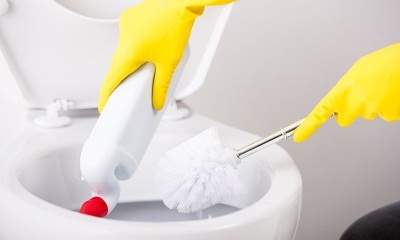 Domestos and Santry gels effectively eliminate the problem. Instructions:
Domestos and Santry gels effectively eliminate the problem. Instructions:
- Wear rubber gloves.
- Remove moisture from the toilet bowl and side walls.
- Apply the concentrate to the bowl.
- Leave for a while for the active ingredients to do their job.
- Clean the toilet with a brush.
- Use the drain button several times.
Household chemicals can only be used for their intended purpose, strictly following the manufacturer’s recommendations.
To combat minor limescale deposits folk remedies are suitable:
- baking soda,
- lemon acid,
- table vinegar.
How to remove limescale in the toilet, will tell you this publication.
How to eliminate blackness?
A type of fungus with a characteristic color settles on old plumbing surfaces, which over time become covered with microcracks and scratches.
If the surface is severely damaged, acid-based solutions and frequent treatment are necessary.
Urine stone
Appears in the toilet if the owners neglect the flush button or it does not cover the entire surface. On the walls of old plumbing fixtures, yellow plaque appears faster due to the abundance of microdamages.
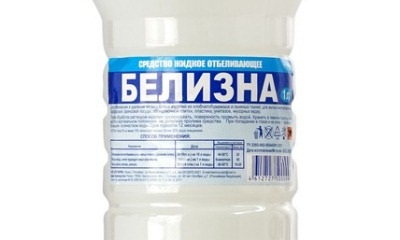 The most effective and inexpensive remedy to combat the problem is “Whiteness”. Mode of application:
The most effective and inexpensive remedy to combat the problem is “Whiteness”. Mode of application:
- Remove water from the toilet.
- Pour a bottle (1 liter) of chlorine onto the walls.
- Leave overnight.
- Clean the bowl with a brush.
- Rinse several times with clean water.
An alternative option is the use of industrial concentrates, for example, “Toilet duckling”.
Household chemical containers for cleaning toilets are equipped with a spout, which easily applies the product even under the headband, it is almost impossible to do this without a special device.
He will tell you how to remove urinary stones from the toilet. this article.
Getting rid of condensation on pipes
The reason for its appearance is the difference between the temperature in the room and the water that enters the tank. The problem can also be caused by excessive humidity in the room, a faulty drain, or too frequent use.
Ways to fix the problem:
- carry out repairs, insulate walls or replace the tank;
- eliminate excess moisture in the room (checking and adjusting ventilation, installing a dehumidifier);
- change the temperature of the water entering the drain (provide warm water, insulate pipes, install a boiler, adjust partial flush).
You can find out how to remove condensation from a toilet tank Here, from cold water pipes in the toilet - here.
Restroom cleaning schedule
So that the problem area shines clean and smells fragrant, as in advertising, required daily:
- disinfect the toilet bowl and lid;
- empty and clean the container for collecting used paper;
- remove fresh contamination from surfaces;
- carry out wet cleaning of the floor.
Learn more about the restroom cleaning schedule. here.
Advice from professionals
Cleaning and disinfecting the toilet requires contact with aggressive components such as chlorine and acid. These substances cope well with the problem, but can harm the health of the owner.
You can avoid this if you follow simple rules:
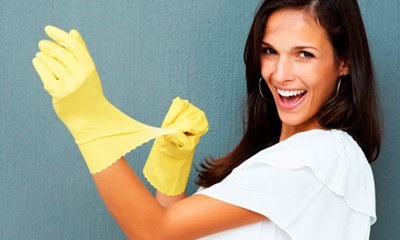 Before cleaning, ensure the room is ventilated: turn on the hood, open doors and windows, if any. After the procedure, the toilet room also needs to be ventilated.
Before cleaning, ensure the room is ventilated: turn on the hood, open doors and windows, if any. After the procedure, the toilet room also needs to be ventilated.- Empty the shelves, take out the excess: air fresheners, hygiene items, towels, soaps and gels.
- Clean only wearing protective equipment, protect your hands with rubber gloves, and protect your upper respiratory tract with a mask or respirator.
- Do not bend low over the toilet when cleaning, do not sniff detergents and disinfectants to avoid contact of aggressive substances with the skin, mucous membranes, eyes, and harmful vapors in the respiratory system.
- Before use, carefully study the instructions on the product label, do not mix incompatible components, and do not exceed the recommended dose.
Rags, sponges, brushes that were used to clean the toilet should not be used under any circumstances to clean other rooms in order to avoid the spread of pathogenic bacteria.
Conclusion
Every housewife can achieve perfect cleanliness of the toilet room and toilet. To do this, it is necessary to regularly carry out cleaning and preventive measures, promptly repair plumbing fixtures and its components, and keep at the ready effective means to combat any type of pollution.
